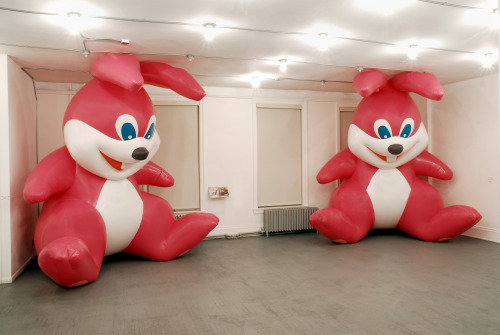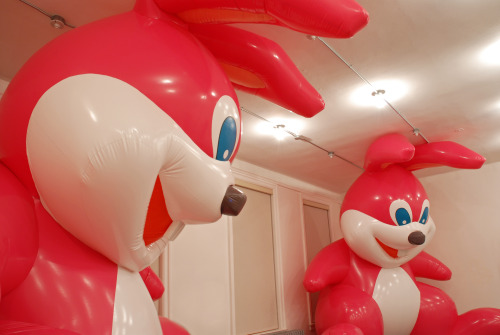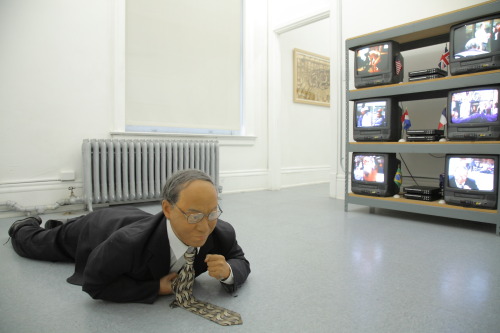Dikeou Superstars: Momoyo Torimitsu

Walking into the main space of the Dikeou Collection, the visitor is greeted by some striking (and somewhat unsettling) characters: two colossal, inflatable, hot-pink bunny rabbits. These rabbits are so massive, in fact, their heads squish against the ceiling, forcing their creepy cartoon eyes down onto the viewer in a fluoride stare. Their uncanny smiles and stretched latex skin make it hard to look away, leading us to question if it’s sympathy, suspicion, or a misunderstood sweetness at the heart of our intrigue. Momoyo Torimitsu, a Japanese artist and creator of the disturbingly saccharine Somehow, I don’t feel comfortable, has succeeded in her plot to disrupt reality through a palpable, yet hard to articulate, feeling of unease.
According to Torimitsu, the innocence implied by the image of a bunny coupled with their disconcerting size and situation is an exploration of cuteness and its limits. This exploration is not simply aesthetic; it is also socially critical. While created for a show in Paris in 2000, the oeuvre stands in conversation with the pervasive influence of kawaii (cute) imagery in Japan, specifically as it relates to consumerism and prescribed gender roles. On her website, Torimitsu writes that the target audience for cute character goods is not only children but also adult women, a fact which demonstrates the entanglement of consumer culture with a conception of gender identity that regulates Japanese women’s ‘ways of communication, negotiation, smiling, and sexuality.’ Though sensational, this piece has the capability to inspire profound meditation on the pressure to conform to societal boundaries that discourage personal expansion and deny full extension of self. Torimitsu argues, via hot-pink inflatable rabbits, for social reformation.

Plastic bunnies aren’t the only way Torimitsu accomplishes social critique. Just a room over from Somehow, I don’t feel comfortable, a man dressed in business attire is poised mid-crawl on the floor. Life-like enough to elicit an ‘oh shit!’ or two, Miyata-san, the primary component of the piece Miyata Jiro, is an automaton that has toured the world with Torimitsu. 6 TV screens on the wall next to the robot (another element of the piece) show the pair out in the streets of New York, Paris, Rio de Janeiro, London, Amsterdam, and Sydney. The TVs display Miyata-san inching jerkily down sidewalks around the world, while Torimitsu, dressed as a nurse, attends to him. Looks of confusion, worry, amusement, wonder, and, sometimes, anger follow them, as people struggle to make sense of Miyata Jiro and their own role in the performance.

Miyata-san crawls to represent his identity as a corporate soldier, debilitated by an obsession to succeed within a capitalist system. Though people (mainly those unsure about whether or not Miyata-san is an actual person) may be concerned for the robot’s well-being, the audience is ultimately powerless to help Miyata-san stand up, stop, or reach his non-existent (and thus, unachievable) destination. In light of this dynamic, this piece can also be read as a meta-commentary on the function of the artist - they may facilitate in the illumination of societal issues but are similarly powerless as an individuals to change the way things are.
Somehow, I don’t feel comfortable and Miyata Jiro shock us into contemplation of darker themes Torimitsu has strategically buried beneath spectacular exteriors. Who knew inflatable bunnies could become a symbol for societal restriction and regulation of identity? Or that an animated android businessman could serve as a metaphor for the futility of modern existence? Bleak and familiar as these messages may be, we can appreciate Torimitsu’s work for its ability to galvanize visceral and psychological reactions that play with our conceptions of the abstract and tangible. Torimitsu’s bunnies and robots hoodwink our imaginations, giving form to greater truths and critical reverie through disturbance and enchantment.
- Mimi King
